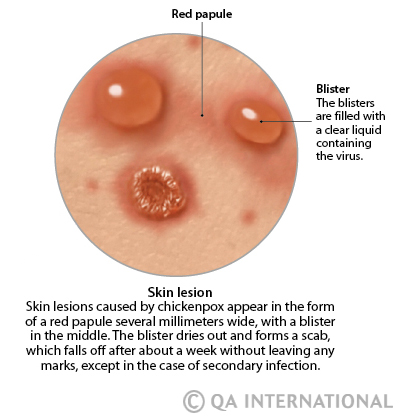
Infectious diseases in children: prevention first! (1st part)
Infectious diseases that specifically affect children are often highly contagious. Transmitted by the inhalation of droplets of infected saliva or by direct contact, they tend to spread chiefly in the winter and spring, especially in schools and day care centers. These diseases are usually benign, only requiring treatment of the symptoms. Some, however, such as whooping cough, measles, and epiglottitis, are more serious and can even be fatal, particularly for those who are immunodeficient or suffering from malnutrition. Many childhood infectious diseases can be prevented by vaccination.
Chickenpox
Chickenpox, which is highly contagious, mainly affects children ages 2 to 10. This infectious disease is caused by the varicella-zona virus, which remains present in the body in a latent state and may recur in adulthood, causing zona. After two weeks of incubation, chickenpox causes a rash on the chest, which gradually extends to the rest of the body. The rash may be preceded by a mild fever and slight fatigue, and is often accompanied by itching. It disappears about ten days later. A person with chickenpox is contagious two days before and five days after the appearance of the rash. Usually benign in children, recovery from chickenpox is spontaneous. Good hygiene and the administration of antihistamines to relieve the itching can help to limit the risks of secondary infection of the lesions due to scratching. The disease is more rare, but also more serious, in adults, particularly in immunodeficient people and pregnant women.

Roseola infantum
Roseola infantum is a relatively widespread, benign viral infection with a low level of contagion, affecting young children. The disease appears with the sudden onset of a high fever (102°F–104°F [39°C–40°C]) over three days. Once the fever has dropped, small pink spots appear on the skin of the torso, then the limbs and the face. The rash then disappears spontaneously after two days. Roseola requires no treatment, other than to reduce the fever.
Measles
Measles is a highly contagious infectious disease caused by a virus of the Morbillivirus genus and characterized by a generalized rash. It mainly affects unvaccinated children. After 8–12 days of incubation, measles appears as a high fever (102°F–104°F [39°C–40°C]), rhinitis (common cold), conjunctivitis, and a characteristic outbreak in the mouth, called Koplik's spots. Red spots then appear on the face and gradually cover the entire body. The patient will remain contagious for four days after the outbreak of the first spots. Measles complications are fairly common and can be serious: diarrhea, acute otitis media, pneumonia, encephalitis, febrile seizures (convulsions), etc. The disease can be dangerous to young children, pregnant women, the immunodeficient, and people suffering from malnutrition. Treatment of the disease involves relieving the symptoms and treating any complications. Systematic vaccination, performed in many countries, has reduced the occurrence of the disease; although close to 350,000 people worldwide—mainly children—die from it each year.

Measles typical rash
Scarlet fever
Scarlet fever is an infectious disease caused by the toxins of the group A streptococcus bacterium. It primarily affects children 5 to 10 years of age. After two to five days of incubation, it causes a sudden, high fever (102°F [39°C]) and sore throat. The lymph nodes in the neck become swollen and painful. Two days later, numerous red spots appear on the skin. The mucous membrane of the tongue is coated in a white layer, which comes off after five days, leaving a bright red color underneath. Scarlet fever is treated with antibiotics. Without treatment, it can lead to serious complications, such as glomerulonephritis and acute rheumatic fever.
Also see:
In the Visual Dictionary:
- "human body" section
- "science" section
In the encyclopedic capsules :
- Hygiene and the prevention of infections
- Respiratory infections: beware of complications!
- The flu – a virus that produces fever
- Gastroenteritis, when food makes you sick
- Travel health — prevention over cure
- Asthma
In the ikonet games:
- Put it in its place!:




